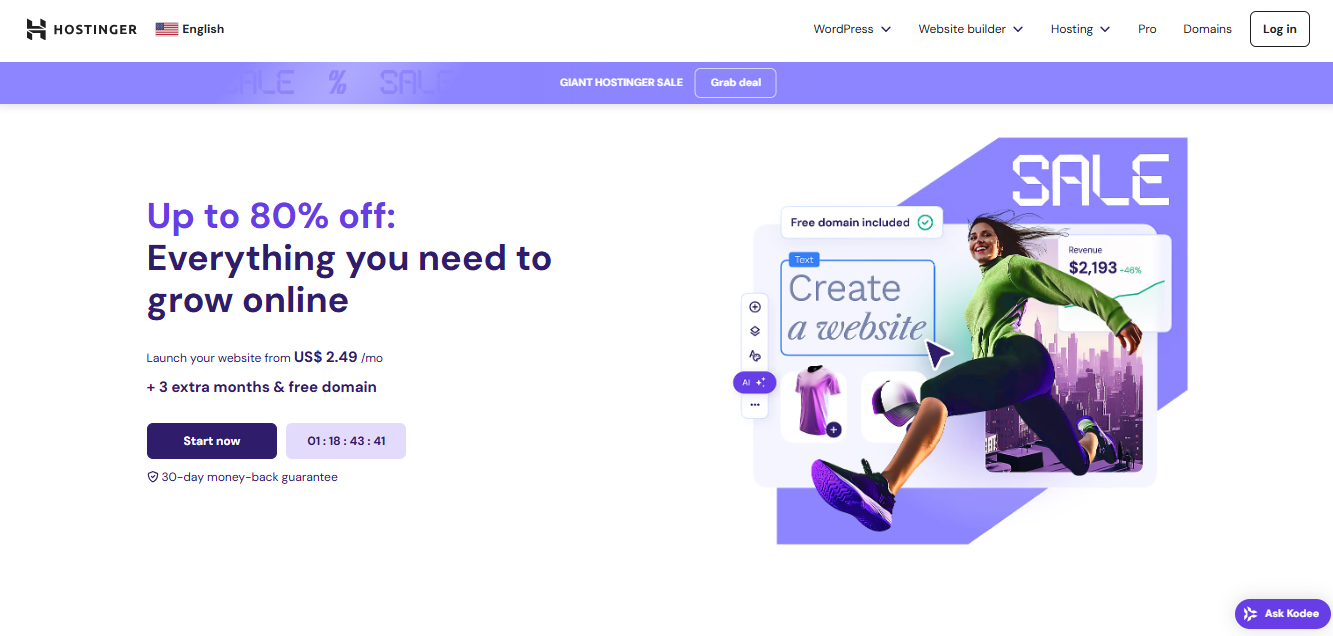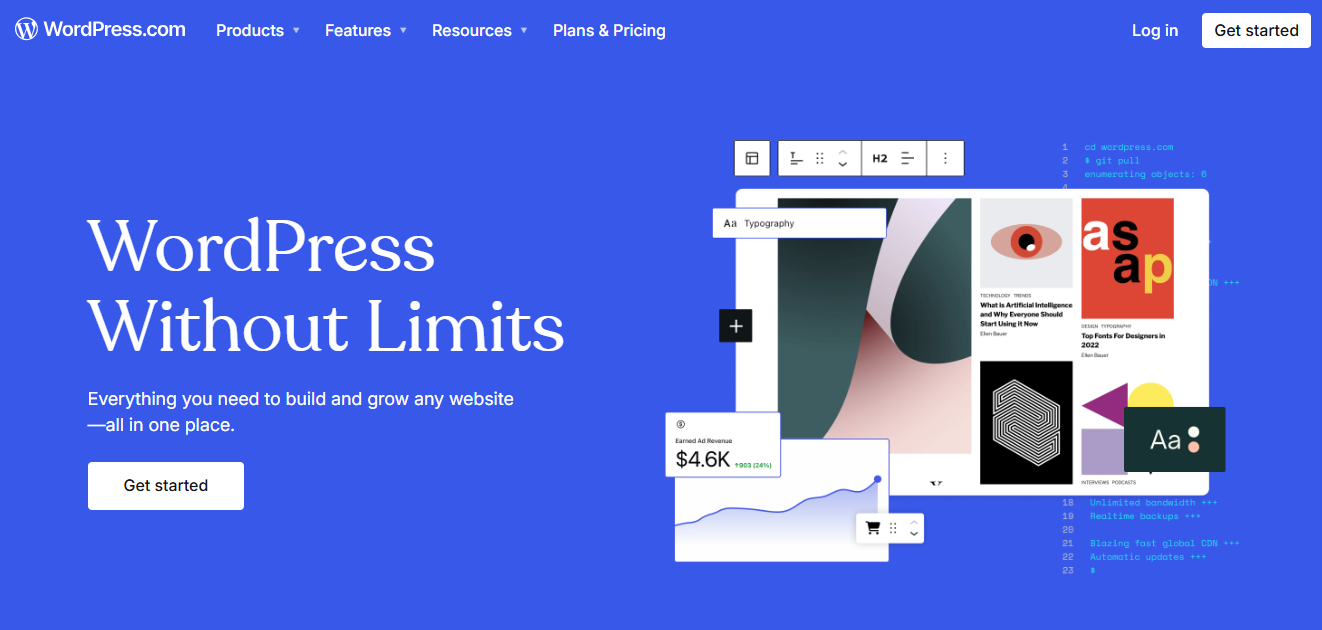
Get Business Email
No domain name required
Hostinger Vs. WordPress
Explore Neo today!
A website is important to every business's success because it brings potential customers and improves sales. Various tools are available to help you develop websites efficiently without having to code them yourself. The two most widely used alternatives are WordPress and Hostinger.
WordPress provides an incredibly robust platform with a vast selection of themes and plugins for individuals who want to build a highly personalized website. On the other hand, Hostinger Website Builder is made to be simple and provides tools that let beginners create a website quickly.
In this article, we'll compare Hostinger website builder and WordPress, comparing their features, design possibilities, affordability, and usability. By the end, you'll better understand which one is ideal for your website's needs.
Overview of Hostinger Website Builder

Hostinger Website Builder is a simple platform that is designed for beginners as well as non-technical users. It has a drag-and-drop interface that makes website development easy for everyone. The Hostinger Website Builder makes it simple to create and maintain a website or online store by offering a variety of templates and integrated AI tools. Although it might not have as many customization choices as WordPress, it is still an excellent option for startup businesses and individual sellers due to its reliable hosting and robust customer service.
Hostinger Website Builder Features
Let’s look at the core features of Hostinger’s website builder:
- Drag-and-Drop Editing. The layout of your website can be easily customized by simply dragging and dropping pre-designed elements, such as buttons and text.
- Templates: Select from a large selection of pre-made templates from various industries. This guarantees that your website will appear polished and up-to-date immediately.
- Mobile Optimization: Use designs that are responsive to mobile devices to reach a larger audience. This ensures a seamless experience for the visitors on the go.
- Ecommerce: Use integrated eCommerce features to sell your goods online. You can incorporate shopping carts, product listings, and safe payment gateways.
- SEO (Search Engine Optimization): Use integrated SEO tools to improve your website's search engine rating and draw in organic traffic.
- Analytics and Marketing: Use a variety of marketing and analytics tools to learn key details about how well your website is performing.
How to Create a Website Using Hostinger?
The steps to setup a website with hostinger website builder are as follows:
Step 1: Sign up for Hostinger Website Builder
Visit the Website Builder page for Hostinger. Just locate their website builder page on their website. Next, take some of the following steps:
- Choose a Plan: Hostinger provides a variety of plans that suit all requirements and budgets. To choose the best option for your website, it is always best to take into account the features that each plan offers.
- Create an Account: After choosing your plan, you will be sent to a screen where you must set up an account by providing your email address and password.
- Payments: To complete your plan selection, finish the payment process. With attractive savings for long-term commitments, Hostinger provides a range of convenient and adaptable payment choices, including monthly, yearly, and multi-year options.
Step 2: Choose a Template
Follow the given steps to help choose a template:
- Explore Hostinger's selection of themed themes, arranged according to website type or industry.
- Next, pick a template. This will determine your brand's appearance and usability.
- Once the template has been chosen, click "Use Template."
- After selecting a template, import it into the editor by clicking the "Use Template" button. This will be the starting point for your website and can be further tailored to your preferences.
Step 3: Customize Your Site
Use these steps to personalize your website:
- Drag-and-Drop Editor Access: The Hostinger editor is user-friendly and simple to use. Drag-and-drop functionality allows you to add, remove, or reorganize elements on each page.
- Edit Text and Images: Type your company information, service descriptions, and other information by tapping on any text field. To add your images to an area of images, simply tap on it.
- Include Features and Widgets: To improve functionality and user experience, you may add a wide range of widgets, contact forms, social media links, galleries, and maps to your sites using the editor.
- Customize Fonts and Colors: It's simple to change the fonts and colors to fit the colors of your brand. You may modify these elements to create a truly unique website with the help of hostinger customization options.
Step 4: Preview and Publish Your Site
Finally, your website is all set for publication and preview. Take the steps given below:
- Preview Your Site: Before your site goes live, you can preview it here. Please check that every element appears correctly on desktop and mobile devices. You can see exactly how it will seem to a visitor by using Hostinger's preview feature.
- Make Final Adjustments: Verify the text, graphics, and alignment to make sure everything functions properly. This is where errors and inconsistencies are found.
- Publish: To make your website online, click the "Publish" button after you are happy with the layout and design. With Hostinger, the publication procedure is quick, so you may start receiving visitors to your website immediately.
Hostinger Pricing Plans
Some of the most reasonably priced plans available are provided by Hosting, which are as follows:
Overview of WordPress and Its Features

WordPress is a highly customizable and adaptable open-source Content Management System (CMS). It is perfect for individuals looking for extensive control over the appearance and functionality of their website. WordPress is ideal for blogs, business websites, and online stores because of its extensive ecosystem of plugins and themes. However, it has a higher learning curve and depends on using hosting providers, which may have an impact on security and performance.
WordPress Features
These features make it ideal for people looking for a hosted solution that is hassle-free.
- Ease of Use: WordPress handles all of the upgrades, security, and hosting so you can focus on producing content. Its simple layout makes it simple to write content, customize pages, and manage media.
- Themes: To give your website a polished, professional appearance, select from a range of professionally created themes. You can personalize each theme by adding your details.
- Built-in Features: To assist you in expanding your website, WordPress comes with built-in features like social sharing, analytics, and SEO tools. Additionally, since many features are built-in, there's no need to install plugins.
- Scalability: As your requirements change, you can upgrade from a free plan. WordPress provides premium subscriptions with cutting-edge features like eCommerce support and custom domains, regardless of whether you're just blogging or starting a business.
- Mobile-Optimized: Each WordPress website you make is responsive to mobile devices, which means it will work and look amazing on any device.
- Security & Maintenance: WordPress takes care of security and updates, so you won't have to worry about keeping your website secure and updated.
How to Build Websites Using WordPress?
These five steps will offer you a strong foundation for your website's setup, regardless of the type of website you design.
Step 1: Create a New Account
To create your new account in a few easy steps, go to WordPress.com and click on Get Started. After that, follow the given steps:
- In order to inform visitors of the purpose of your website, you will be required to select a name.
- After you've decided on the ideal name, go to General Settings and set it as your Site Title. Here, too, you can include a memorable tagline!
- You already have a website address when you sign up, such as yoursite.WordPress.com.
- Take your domain to the next level, such as yourdomain.com.
- With any one-year or multi-year WordPress.com plan, you can register any available domain for free for the first year.
Step 2: Design Your Homepage
Make a good first impression by personalizing the homepage, or home page, of your website. To personalize the design, you can load any of the stunning themes and then alter, add, or delete any components.
Understand “blocks”, which serve as the foundation for your website. You may utilize blocks to include almost anything on your pages, including photos, galleries, columns, videos, payment buttons, and much more.
Use block patterns to leverage the design skills of others. These are exquisitely crafted, readily available sets of blocks that you can add with a few clicks to create any layout you can imagine.
Step 3: Create More Pages
About and Contact pages are the most often visited pages on a website, aside from the homepage. To create a new page, start from your dashboard, select Pages, and then Add New Page.
A premade page layout can be used as a starting point, and you can customize it by adding or deleting content as necessary. To make your setup, you can also start from scratch and add blocks or block patterns.
Step 4: Set Up Your Menu
Readers can navigate a website by clicking on the links presented in the menu at the top. The pages you made in Step 3 can now be added. To begin, select Appearance, then Editor, and make changes to the Navigation block (or, for classic themes, Appearance and then Menus).
Step 5: Establish a Social Media Account
Your website is the ideal platform for promoting your social media presence. Using the Social Icons block, you may include these icons in the menu of your website.
Step 6: Launch your Website.
You have a strong foundation for your website if you have finished these five steps. Go ahead and launch it if you're prepared to share it with the world.
WordPress Pricing Plans
WordPress provides a free plan with limited customization. However, there are a variety of plans based on your needs to create the number of websites you want, and they are as follows:
WordPress vs Hostinger Website Builder: A Quick Review
Let's quickly review the main differences between Hostinger and WordPress before we wrap up.
Note: We have provided our ratings after a thorough assessment of both platforms on the basis of different parameters, like pricing, ease of use, hosting plans offers, website builder features, and others.
How Neo Website Builder Can Be a Better Choice?
Hostinger and WordPress are the most effective website builders out there. However Neo AI website builder is created to make web design simple and accessible for all users, whether they are starting a new business or updating an existing one. By just providing your business name and description, Neo's AI website builder makes the process of building a website much simpler.
Neo AI website builder will start processing your request and will quickly create a stunning website for you. For instance, take a look at this VistaInteriors website created using Neo AI website builder.

You can recreate the design, content, or entire website as many times as you like. Neo's AI website builder will generate a ready-to-launch website that you can further customize as needed by applying a number of amazing website templates, themes, and a simple site editor.
All of these templates are optimized for various other types of devices and screen sizes, so they look great no matter where you view them.
Conclusion
Your individual needs, goals, and long-term plans select the best platform for your website. Suppose you want something simple, cost-effective, and easy to manage. In that case, the Hostinger Website Builder is a good solution. Its drag-and-drop interface and pre-designed templates make the procedure simple.
On the other hand, if you intend to scale your website, demand more customization, or are a content producer or business owner who requires additional capabilities, WordPress provides you with greater flexibility and control. And if you want to create a stunning website that stands out without any coding knowledge, Neo AI website builder is a powerful software. Create your website for free in minutes with our AI website builder today!
Frequently Asked Questions (FAQs)
1. Which platform is best for beginners among WordPress and Hostinger Website Builder?
Hostinger Website Builder is more user-friendly for beginners because it has a drag-and-drop interface and real-time editing. This makes website development accessible to everyone, even those with no coding experience.
2. Can I use WordPress and Hostinger Website Builder for eCommerce?
Yes, both platforms support ecommerce. WordPress, with plugins such as WooCommerce, provides important ecommerce functionality and customization choices, making it suitable for businesses wishing to expand. Hostinger Website Builder offers basic eCommerce tools that are ideal for smaller-scale web enterprises.
3. What are the main differences in pricing and functionality between WordPress and Hostinger Website Builder?
WordPress is an open-source platform that is free to use. However, hosting, themes, and plugins can lead to additional expenses. Hostinger Website Builder provides transparent pricing with particular plans, making it easier for customers to understand the overall cost upfront.

Get Business Email
No domain name required
Hostinger Vs. WordPress
Explore Neo today!





.svg%201.svg)
.svg)
.svg)
.svg%201.svg)



